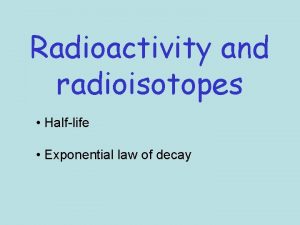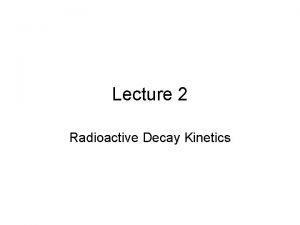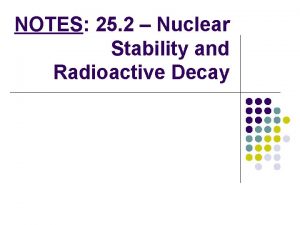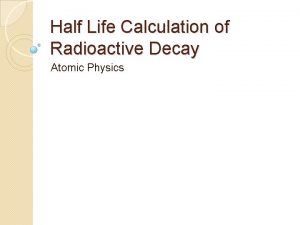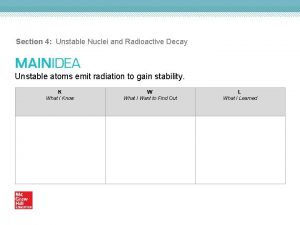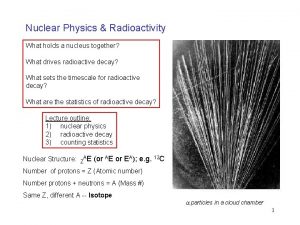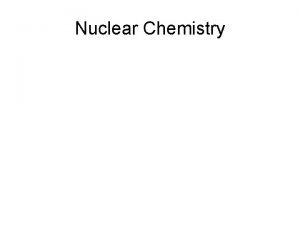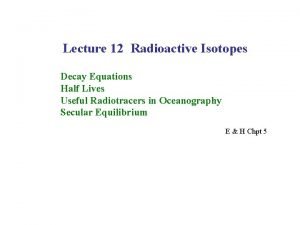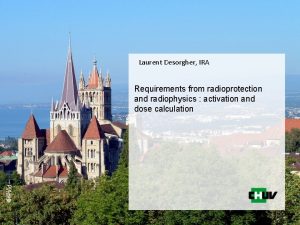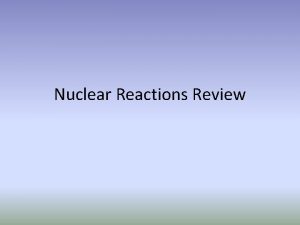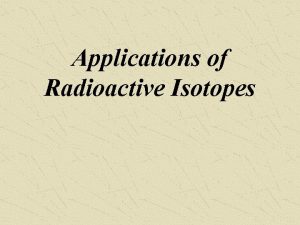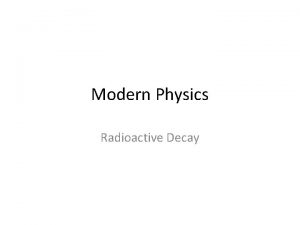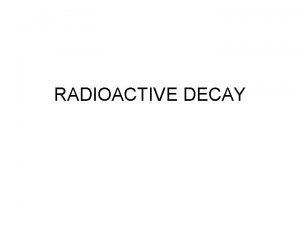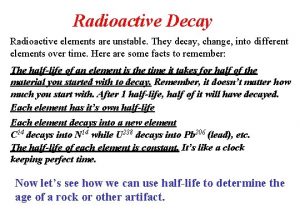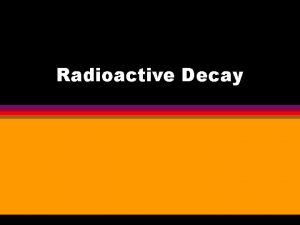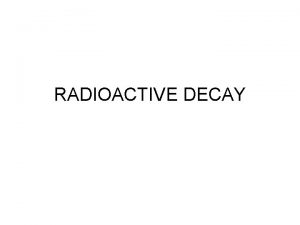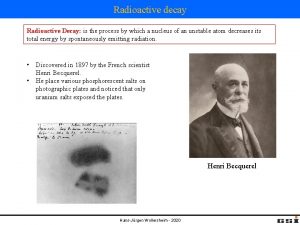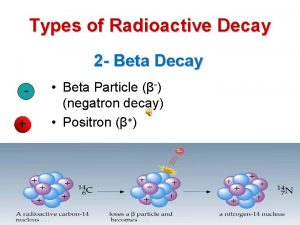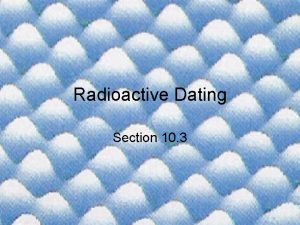Types of Radioactive Decay Types of Radioactive Decay

















- Slides: 17

Types of Radioactive Decay

Types of Radioactive Decay • There are six common types of radioactive decay. – Alpha emission (abbreviated a): emission of a nucleus, or alpha particle, from an unstable nucleus. – An example is the radioactive decay of radium-226. www. assignmentpoint. com

Types of Radioactive Decay • There are six common types of radioactive decay. (see Table 21. 2) – Beta emission (abbreviated b or b-): emission of a high speed electron from a stable nucleus. – This is equivalent to the conversion of a neutron to a proton. www. assignmentpoint. com

Types of Radioactive Decay • There are six common types of radioactive decay. (see Table 21. 2) – Beta emission (abbreviated b or b-): emission of a high speed electron from a stable nucleus. – An example is the radioactive decay of carbon-14. www. assignmentpoint. com

Types of Radioactive Decay • There are six common types of radioactive decay. – Positron emission (abbreviated b+): emission of a positron from an unstable nucleus. – This is equivalent to the conversion of a proton to a neutron. www. assignmentpoint. com

Types of Radioactive Decay • There are six common types of radioactive decay. – Positron emission (abbreviated b+): emission of a positron from an unstable nucleus. – The radioactive decay of techencium-95 is an example of positron emission. www. assignmentpoint. com

Types of Radioactive Decay • There are six common types of radioactive decay. – Electron capture (abbreviated EC): the decay of an unstable nucleus by capturing, or picking up, an electron from an inner orbital of an atom. – In effect, a proton is changed to a neutron, as in positron emission. www. assignmentpoint. com

Types of Radioactive Decay • There are six common types of radioactive decay. – Electron capture (abbreviated EC): the decay of an unstable nucleus by capturing, or picking up, an electron from an inner orbital of an atom. – An example is the radioactive decay of potassium 40. www. assignmentpoint. com

Types of Radioactive Decay • There are six common types of radioactive decay. – Gamma emission (abbreviated g): emission from an excited nucleus of a gamma photon, corresponding to radiation with a wavelength of about 10 -12 m. – In many cases, radioactive decay produces a product nuclide in a metastable excited state. www. assignmentpoint. com

Types of Radioactive Decay • There are six common types of radioactive decay. – Gamma emission (abbreviated g): emission from an excited nucleus of a gamma photon, corresponding to radiation with a wavelength of about 10 -12 m. – The excited state is unstable and emits a gamma photon and goes to a lower energy state. www. assignmentpoint. com

Types of Radioactive Decay • There are six common types of radioactive decay. – Gamma emission (abbreviated g): emission from an excited nucleus of a gamma photon, corresponding to radiation with a wavelength of about 10 -12 m. – An example is metastable technetium-99. www. assignmentpoint. com

Types of Radioactive Decay • There are six common types of radioactive decay. – Spontaneous fission: the spontaneous decay of an unstable nucleus in which a heavy nucleus of mass number greater than 89 splits into lighter nuclei and energy is realeased. – For example, uranium-236 undergoes spontaneous fission. www. assignmentpoint. com

Predicting the Type of Radioactive Decay • Nuclides outside the band of stability are generally radioactive. – Nuclides to the left of the band have more neutrons than that needed for a stable nucleus. – These nuclides tend to decay by beta emission because it reduces the neutron-to-proton ratio. www. assignmentpoint. com

Predicting the Type of Radioactive Decay • Nuclides outside the band of stability (Figure 21. 3) are generally radioactive. – In contrast, nuclides to the right of the band of stability have a neutron-to-proton ratio smaller than that needed for a stable nucleus. – These nuclides tend to decay by positron emission or electron capture because it increases the neutron to proton ratio. www. assignmentpoint. com

Predicting the Type of Radioactive Decay • Nuclides outside the band of stability are generally radioactive. – In the very heavy elements, especially those with Z greater than 83, radioactive decay is often by alpha emission. www. assignmentpoint. com

A Problem To Consider • Predict the expected type of radioactive decay for each of the following radioactive nuclides. – The atomic weight of calcium is 40. 1 amu, so you expect calcium-40 to be a stable isotope. – Calcium-47 has a mass number greater than that of the stable isotope, so you would expect it to decay by beta emission. www. assignmentpoint. com

A Problem To Consider • Predict the expected type of radioactive decay for each of the following radioactive nuclides. – The atomic weight of aluminum is 27. 0 amu, so you expect aluminum-27 to be a stable isotope. – Aluminum-25 has a mass number less than that of the stable isotope, so you would expect it to decay by positron emission or electron capture. www. assignmentpoint. com
 Exponential law
Exponential law Calculation of radioactive decay
Calculation of radioactive decay Radioactive decay law
Radioactive decay law Radioactive decay
Radioactive decay How to calculate half life physics
How to calculate half life physics Unstable nuclei and radioactive decay
Unstable nuclei and radioactive decay Radioactive decay law
Radioactive decay law Chemistry images
Chemistry images Radioactive decay formula
Radioactive decay formula Calculation of radioactive decay
Calculation of radioactive decay Type of radioactive decay
Type of radioactive decay Beta decay
Beta decay How to find the decay factor from a table
How to find the decay factor from a table Conclusion of radiation pollution
Conclusion of radiation pollution Most unstable radioactive element
Most unstable radioactive element Radioactive materials have unstable
Radioactive materials have unstable 12x12x12x12x12x12x12
12x12x12x12x12x12x12 Uses of radioactive isotopes
Uses of radioactive isotopes
